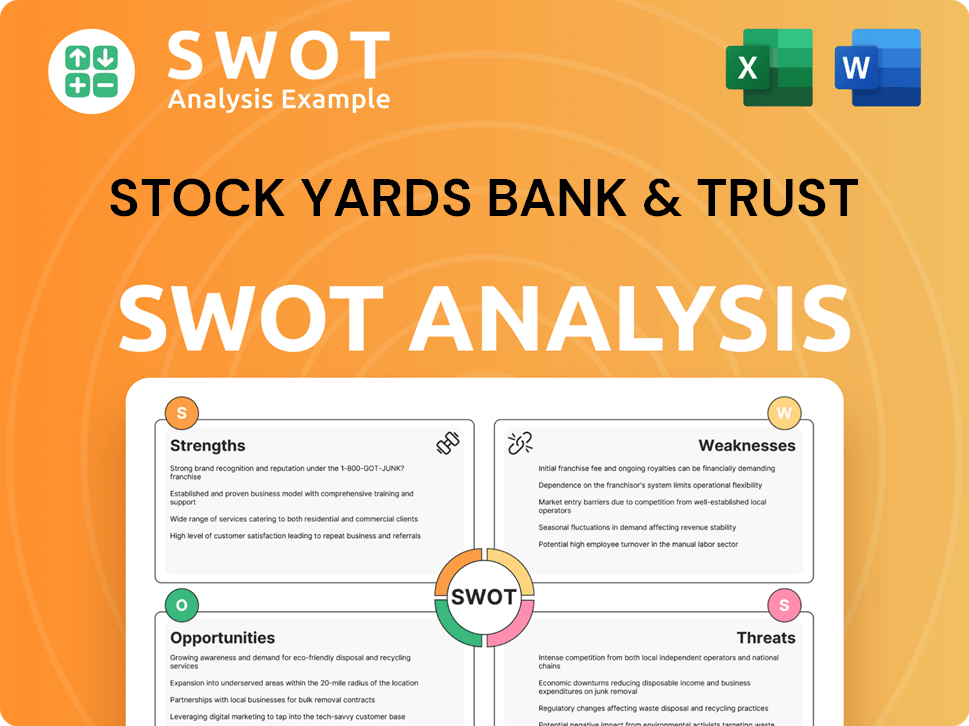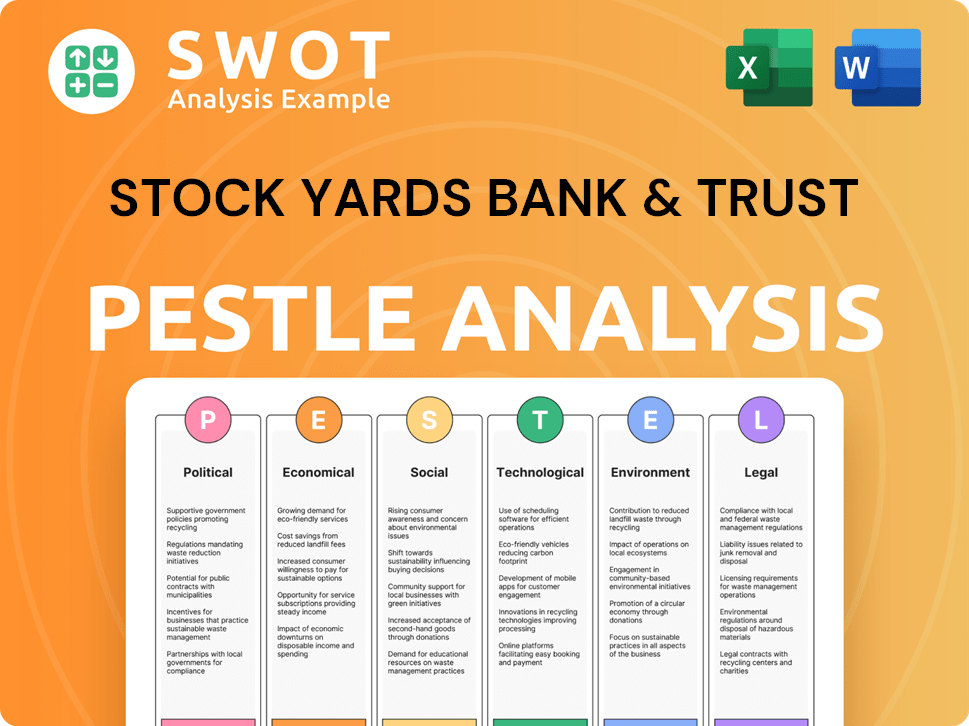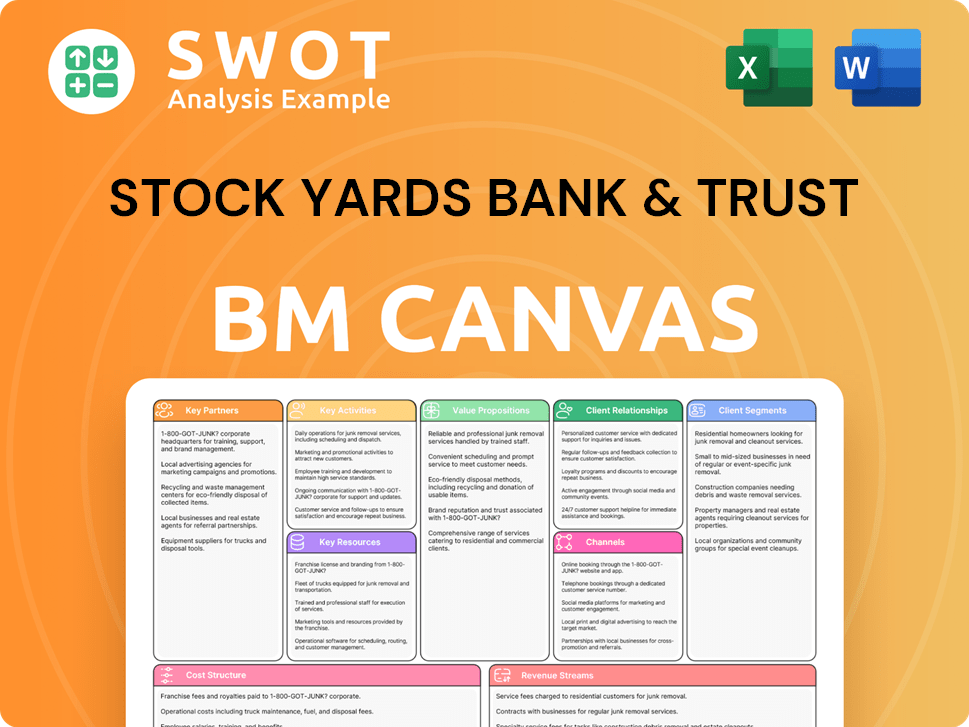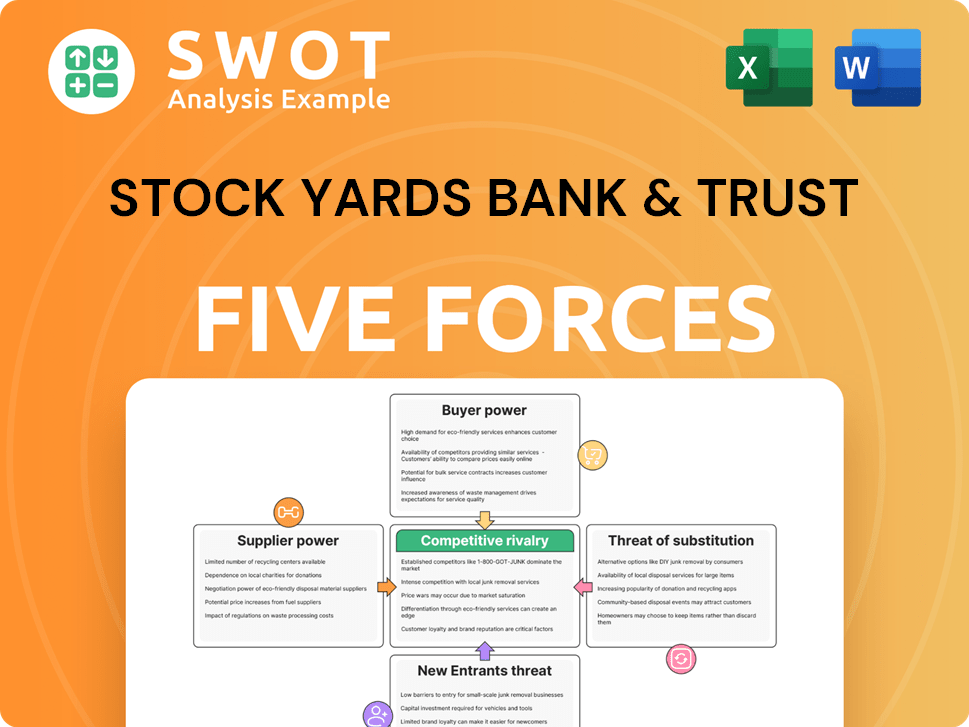Stock Yards Bank & Trust Bundle
Who Really Controls Stock Yards Bank & Trust Company?
Understanding the ownership structure of Stock Yards Bank & Trust Company is key to grasping its strategic direction and future prospects. Knowing who owns a financial institution like Stock Yards Bank directly impacts its operational strategies and its commitment to its stakeholders. This exploration unveils the forces shaping this nationally recognized financial institution, from its roots in Louisville, Kentucky, to its current standing as a significant player in the financial landscape.

Founded in 1904, Stock Yards Bank & Trust Company has transformed significantly, now operating as a wholly-owned subsidiary of Stock Yards Bancorp, Inc. (NASDAQ: SYBT). With substantial assets and a strong presence in Kentucky, Indiana, and Ohio, understanding the Stock Yards Bank & Trust SWOT Analysis is crucial. This analysis will delve into the bank's ownership evolution, providing insights into its leadership and financial performance, and answering questions like "Who owns Stock Yards?" and "Is Stock Yards Bank publicly traded?"
Who Founded Stock Yards Bank & Trust?
The establishment of Stock Yards Bank & Trust Company (SYBT) in 1904 marked the beginning of a financial institution deeply rooted in the Louisville, Kentucky, community. The bank's formation was a direct response to the needs of local businesses, specifically those involved in the agricultural and commercial sectors, with a strong focus on the livestock trade.
The initial vision for Stock Yards Bank came from a group of Louisville business leaders who saw an opportunity to support local economic activities. Their goal was to create a financial institution that understood and catered to the specific needs of the livestock industry, which was a significant part of the local economy at the time. This strategic focus set the stage for the bank's early operations and its role in the community.
The bank's initial capital was set at $100,000, raised through the sale of shares. This funding allowed the bank to begin operations and provide financial services to its target market. The strategic location of the bank, near the businesses of its founding members, underscores its commitment to serving the local industry.
The initial investors included John Letterle, Henry Embry, Wallace Embry, Anton Zehnder, Lytle Hudson, Clay McCandless, Taylor Watkins, B. Mattingly, Louis Bornwasser, and Charles Wulkop.
Eight out of the ten initial investors were involved in the livestock trade, highlighting the bank's commitment to serving this industry.
Stock Yards Bank officially opened its doors on Saturday, September 17, 1904, a strategic choice reflecting the importance of Saturdays for livestock traders' sales.
The initial capitalization for Stock Yards Bank was $100,000, derived from the sale of 1,000 shares at $100 each.
The first meeting to form the bank took place on June 9, 1904.
The bank's early operations were closely tied to the livestock trade, with many of the founding members' businesses located near the bank's current location.
The early ownership of Stock Yards Bank & Trust Company was concentrated among a group of local business leaders, primarily involved in the livestock trade. This concentration of ownership reflects the bank's initial focus on serving the financial needs of this specific industry. While detailed information on specific equity splits or early agreements is not readily available in public historical records, the bank's formation and early operations were clearly driven by a commitment to supporting the local economy. For more insights, you can explore the Growth Strategy of Stock Yards Bank & Trust.
Stock Yards Bank & Trust SWOT Analysis
- Complete SWOT Breakdown
- Fully Customizable
- Editable in Excel & Word
- Professional Formatting
- Investor-Ready Format

How Has Stock Yards Bank & Trust’s Ownership Changed Over Time?
The ownership structure of Stock Yards Bank & Trust Company, operating under the holding company Stock Yards Bancorp, Inc. (SYBT), is a blend of institutional, insider, and retail investors. As a publicly traded entity, SYBT's shares are available on the open market, which means it adheres to strict regulatory and reporting standards. This structure allows for a diverse investor base and ensures transparency in its operations.
The evolution of Stock Yards Bank & Trust Company's ownership has been marked by strategic decisions, including the formation of Stock Yards Bancorp in 1988. This move was pivotal, setting the stage for expansion and diversification. Further growth was achieved through acquisitions, such as United Bancorp, Inc. of Kentucky in 1997, Bank of Oldham County, Inc. in 2006, Kentucky Bancshares, Inc. in 2015, and the merger with CBT Financial in 2022. These acquisitions have significantly impacted the bank's footprint and investor base over time.
| Ownership Category | Approximate Percentage (May 9, 2025) | Key Stakeholders (March 31, 2025) |
|---|---|---|
| Institutional Investors | 62% | BlackRock, Inc. (6.8%), The Vanguard Group, Inc. (6.3%), Neuberger Berman Investment Advisers LLC (5.2%), Victory Capital Management Inc. (4.61%), Kayne Anderson Rudnick Investment Management LLC (4.34%), Stock Yards Bank & Trust Co. (3.52%), Dimensional Fund Advisors, Inc. (3.17%) |
| Insiders | 2.3% (January 2025) | Executives and Board Members |
| Retail Investors | 30% (May 9, 2025) | Individual Investors |
As of May 9, 2025, institutional investors hold a substantial 62% stake in SYBT, demonstrating strong confidence from professional investment firms. BlackRock, Inc. is the largest shareholder, with 6.8% of outstanding shares. Insiders, including executives and board members, own around 2.3%, aligning their interests with the company's performance. Retail investors hold approximately 30% of the shares. For more insights into the competitive landscape, you can explore the Competitors Landscape of Stock Yards Bank & Trust.
Stock Yards Bank & Trust Company's ownership structure is diverse, with significant institutional investor participation.
- Institutional investors hold the majority of shares, indicating strong market confidence.
- Insiders maintain a small percentage, aligning their interests with the company's success.
- Retail investors make up a considerable portion of the ownership, reflecting public interest.
- The company's history includes strategic acquisitions that have shaped its current ownership.
Stock Yards Bank & Trust PESTLE Analysis
- Covers All 6 PESTLE Categories
- No Research Needed – Save Hours of Work
- Built by Experts, Trusted by Consultants
- Instant Download, Ready to Use
- 100% Editable, Fully Customizable

Who Sits on Stock Yards Bank & Trust’s Board?
The Board of Directors of Stock Yards Bancorp, Inc. oversees the strategic direction and financial performance of the company, representing shareholder interests. As of March 12, 2025, the Board comprises eleven members, with a majority of independent directors. This structure ensures a balance of perspectives and promotes effective governance.
Key figures on the board include James A. Hillebrand, who serves as Chairman and Chief Executive Officer of both Stock Yards Bancorp, Inc. and its subsidiary, Stock Yards Bank & Trust Company, since January 1, 2021. Other notable members include Paul J. Bickel III and Richard A. Lechleiter. The Board operates through committees such as Audit, Compensation, and Risk, which review key company practices. This structure is designed to maintain oversight and ensure accountability within the financial institution.
| Board Member | Title | Key Role |
|---|---|---|
| James A. Hillebrand | Chairman and CEO | Oversees overall company strategy and operations |
| Paul J. Bickel III | Director | Provides expertise in business and strategy |
| Richard A. Lechleiter | Director | Offers insights into community and educational initiatives |
The voting structure at Stock Yards Bancorp is straightforward, with a one-share-one-vote system. As of March 1, 2024, there were 29,366,737 shares of Common Stock outstanding. Proxies, such as James A. Hillebrand and Philip S. Poindexter, are designated to cast votes according to shareholder instructions. The company's commitment to transparency and accountability is evident in its corporate governance guidelines. For more insights into the company's approach to business, you can read about the Marketing Strategy of Stock Yards Bank & Trust.
The Board of Directors at Stock Yards Bank & Trust Company is composed of experienced professionals. The company operates with a clear voting structure, ensuring shareholder rights are protected. The leadership team focuses on transparency and accountability.
- The Board has eleven members as of March 12, 2025.
- James A. Hillebrand is the Chairman and CEO.
- One-share-one-vote voting system.
- Nearly 29.4 million shares outstanding as of March 1, 2024.
Stock Yards Bank & Trust Business Model Canvas
- Complete 9-Block Business Model Canvas
- Effortlessly Communicate Your Business Strategy
- Investor-Ready BMC Format
- 100% Editable and Customizable
- Clear and Structured Layout

What Recent Changes Have Shaped Stock Yards Bank & Trust’s Ownership Landscape?
In the past few years, Stock Yards Bank & Trust Company, also known as SYBT, has shown consistent financial strength and strategic expansion. The bank reported record earnings in both the fourth quarter of 2024, at $31.7 million, and the first quarter of 2025, reaching $33.3 million. As of March 31, 2025, the company's total equity to assets stood at 10.84%, and its tangible common equity ratio was 8.72%, demonstrating strong capital positions that surpass regulatory requirements.
Ownership trends reveal a stable presence from institutional investors. As of May 2025, institutional holdings in Stock Yards Bancorp remained relatively unchanged at 61.39%. Insider holdings slightly decreased from 2.16% to 2.15%. Mutual fund holdings also stayed consistent at 49.59%. Key institutional shareholders as of March 31, 2025, included BlackRock Inc. with 6.83%, Vanguard Group Inc. at 6.41%, and Neuberger Berman Group LLC holding 5.2%.
Regarding capital allocation, Stock Yards Bancorp has not repurchased shares since 2020. However, approximately 741,000 shares were still eligible for repurchase under a buy-back plan expiring in May 2025. The company has consistently focused on capital strategies to increase shareholder value. This includes a sustained dividend payout ratio, with 17 dividend increases since 2012, resulting in a cumulative increase of 158%. The board of directors declared a quarterly cash dividend of $0.31 per common share in February 2025, which was paid on April 1, 2025.
David P. Heintzman plans to retire from the Board of Directors on July 15, 2025, after a 40-year tenure, including serving as CEO and Chairman. The bank continues to seek strategic acquisitions to foster organic growth.
In March 2025, S&P Global Market Intelligence recognized Stock Yards as one of the Top 50 Best Performing Community Banks with assets between $3 billion and $10 billion, based on performance at the end of 2024.
Stock Yards Bank & Trust Porter's Five Forces Analysis
- Covers All 5 Competitive Forces in Detail
- Structured for Consultants, Students, and Founders
- 100% Editable in Microsoft Word & Excel
- Instant Digital Download – Use Immediately
- Compatible with Mac & PC – Fully Unlocked

Related Blogs
- What are Mission Vision & Core Values of Stock Yards Bank & Trust Company?
- What is Competitive Landscape of Stock Yards Bank & Trust Company?
- What is Growth Strategy and Future Prospects of Stock Yards Bank & Trust Company?
- How Does Stock Yards Bank & Trust Company Work?
- What is Sales and Marketing Strategy of Stock Yards Bank & Trust Company?
- What is Brief History of Stock Yards Bank & Trust Company?
- What is Customer Demographics and Target Market of Stock Yards Bank & Trust Company?
Disclaimer
All information, articles, and product details provided on this website are for general informational and educational purposes only. We do not claim any ownership over, nor do we intend to infringe upon, any trademarks, copyrights, logos, brand names, or other intellectual property mentioned or depicted on this site. Such intellectual property remains the property of its respective owners, and any references here are made solely for identification or informational purposes, without implying any affiliation, endorsement, or partnership.
We make no representations or warranties, express or implied, regarding the accuracy, completeness, or suitability of any content or products presented. Nothing on this website should be construed as legal, tax, investment, financial, medical, or other professional advice. In addition, no part of this site—including articles or product references—constitutes a solicitation, recommendation, endorsement, advertisement, or offer to buy or sell any securities, franchises, or other financial instruments, particularly in jurisdictions where such activity would be unlawful.
All content is of a general nature and may not address the specific circumstances of any individual or entity. It is not a substitute for professional advice or services. Any actions you take based on the information provided here are strictly at your own risk. You accept full responsibility for any decisions or outcomes arising from your use of this website and agree to release us from any liability in connection with your use of, or reliance upon, the content or products found herein.